The way we house our Eclectus Parrots depends a lot on where in this world we live. For example, if you live in the northern hemisphere, then consideration must be given to keeping these birds warm during harsh winters. Most pet Eclectus owners in the United States keep their birds indoors all year round, which in itself creates problems. With lack of sunshine, which is their main source of vitamin D, birds kept indoors must be given periods of direct sunshine at least once a week. It is a misconception that a vitamin supplement can replace natural sunshine. Eclectus cannot and should not be given commercially made vitamins that will affect the liver and will most certainly shorten their life.
Living in the southern hemisphere can also have its problems. Extreme hot and dry climates can be as bad for Eclectus if they are not given added protection from this extreme dry weather. Living here in Australia, we provide outdoor aviaries or breeding flights. These flights are usually 25ft. to 30 ft. long (7.6 to 9.14 meters long) and 6ft. to 8ft. (1.8 to 2.4 m high) and 6ft.wide (1.8m wide). These aviaries are usually built in banks of eight to ten flights with a shelter area and rear service passageway at the rear, which allows for easy cleaning, and feeding and checking of nesting boxes. Most aviaries built here on the eastern coast of Australia face in a north easterly direction, as most of our cold weather comes from the south west, so protection is given to that direction. Aviaries facing in a northeasterly direction also get the morning sunshine, which is very important for breeding pairs; they enjoy siting, preening and interacting with each other. Mating is also observed in the early morning.
Overhead sprinklers are provided on top of these breeding flights and during the spring and summer months, they are turned on for about 20 minutes at least once per day and twice a day during hot dry weather. Eclectus parrots love to bathe and even birds in a pet situation should be provided with a shower or even a mist spray by hand at least once a week. This will encourage them to preen and maintain their feathers in good condition. The shelter area must be at least a third of the aviary to allow the birds to shelter if the weather is bad or to hot, so shade should be provided. Some breeders provide shade on part of the roof at the open end of the flight. This can be either clear fibreglass sheeting or shade cloth. I personally prefer shade cloth, as it allows the rain to filter through and the birds seem to enjoy it. It also provides some protection from birds of prey such as hawks and falcons. Most of my birds prefer to roost out in the open end of these flights, so its added protection against owls as well.
Aviaries built in the United States are built for colder climates and are usually in the style of a shed or barn with external flights protruding from both sides. The internal part of the barn houses the birds during the winter months. During spring, the side doors to the open flights are opened and the birds can fly in and out, with the inner part becoming their shelter and nesting area. These barns are wide enough to allow plenty of access for the breeder to service, and clean and monitor nesting activity. The aviary area inside the shed is wide enough for winter holding flights, and the aviary is large enough to house breeding pairs for the winter. This area can be heated during extremely cold weather. Seed and food preparation is housed in another building away from the birds.
All the subspecies do much better in an aviary situation rather than the smaller portable or suspended enclosures. Commercial breeders or breeders that produce birds for the pet trade seem to prefer the suspended or portable style of aviary. This is mainly because they are easier to maintain and can be moved indoors when the weather turns bad. These portable aviaries can also be relocated to another site to allow for the grass to regenerate. Relocation can also stimulate breeding and pair bonding. Some breeding pairs that, for some reason, have stopped breeding are moved to another location and maybe placed along side an unfamiliar pair, will suddenly start producing again. In a fixed aviary situation, breeding pairs that have stopped breeding have to be caught and relocated to a different aviary. This is stressful on the birds and may take a few weeks for them to settle and start breeding again.
Whichever style of aviary you provide, it is important to fit them out with the proper type of perch. Perches for Eclectus parrots should be of soft wood with a bark that they can chew. This keeps their beaks in good condition and also gives the birds something to do. Hardwood, plastic or metal perches should not be used. Fresh, chewable branches containing blossoms and seeds should be provided at least once a week. Eclectus parrots are very active and having something for them to chew and play in is important for their long term breeding future.
Housing multiple pairs in a colony system is also possible with Eclectus parrots. In the wild, Eclectus parrots breed in close proximity to other breeding pairs. I have seen up to four pairs of Australian Eclectus breeding in the same tree, so they do well in a colony system. The only difficulty is keeping tabs on young fledglings when they leave the nest. Banding the chicks in the nest just after they have broken colour can do this. It is also important that before the adult pairs are placed in this aviary, they are also banded and records kept so that when their fledglings leave the nest you can identify the parents. If Eclectus parrots are to be bred in a colony system, it very important that the subspecies are not mixed. This would produce crossbred birds, and as breeders of these birds we should do our best to make sure we keep the subspecies pure.
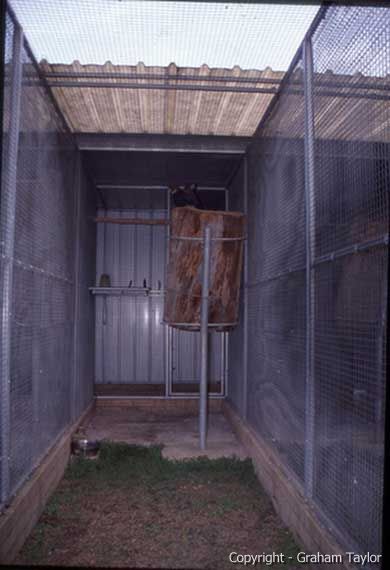 Caption 001: A suitable size outdoor flight aviary for Eclectus Parrots. Graham Taylor. 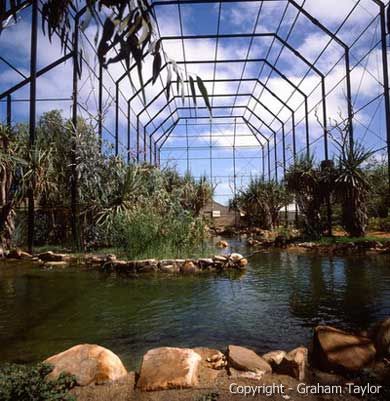 Caption 002: This aviary for Eclectus Parrots at the Pearl Coast Zoo in Western Australia was the largest in the Southern Hemisphere. Max Lawrence.
Caption 003: Breeding pair of Eclectus roratus macgillivrayi housed in a large flight aviary at the Pearl Coast Zoo, Western Australia. Graham Taylor.
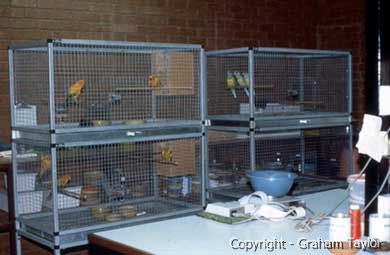 Caption 004: Portable holding or breeding cages at the Pearl Coast Zoo, Broome Western Australia. Graham Taylor. 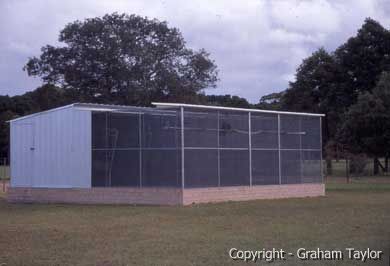 Caption 005: Suitable design and size aviary for Eclectus Parrots. Graham Taylor. 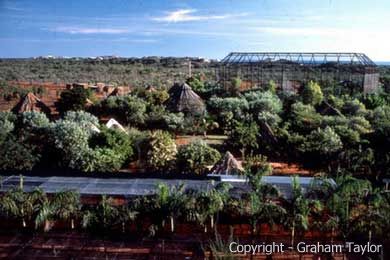 Caption 006: Aviaries at the Pearl Coast Zoo in Broome, Western Australia. Max Lawrence.  Caption 007: Bank of breeding aviaries owned by Graham Bradley, Australia. Graham Taylor. 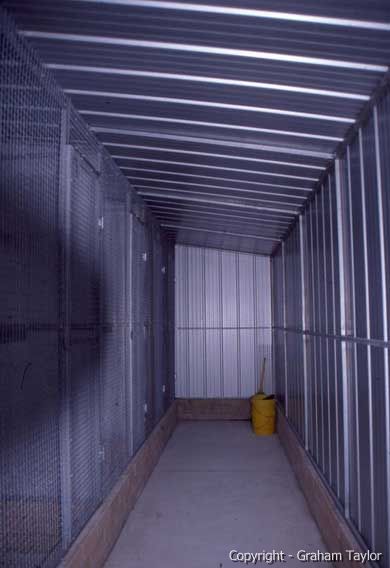 Caption 008: Aviary service area at the rear of the breeding flights. Graham Taylor. 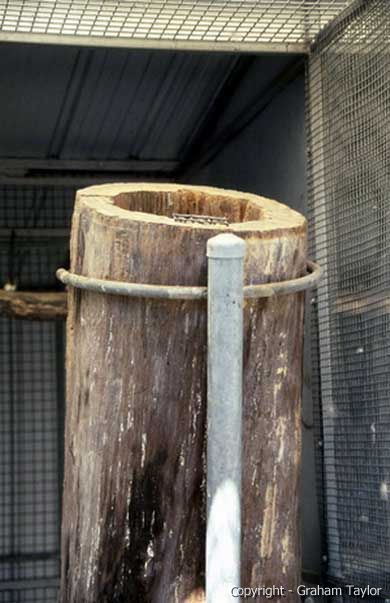 Caption 009: Nesting log suitable for Eclectus Parrots. Graham Taylor. 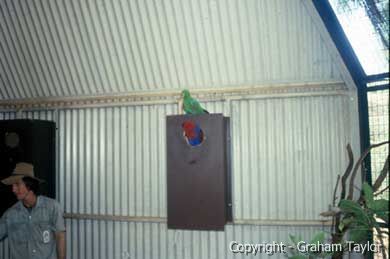 Caption 010: Nest size used for Australian Eclectus Parrots at the Pearl Coast Zoo, Western Australia. Graham Taylor. 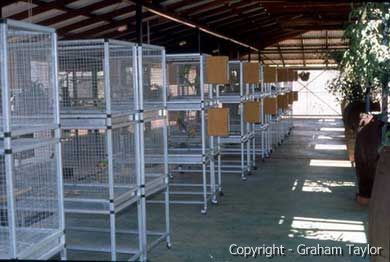 Caption 011: Portable conure breeding aviaries at Pearl Coast Zoo, Broome Western Australia. Graham Taylor. 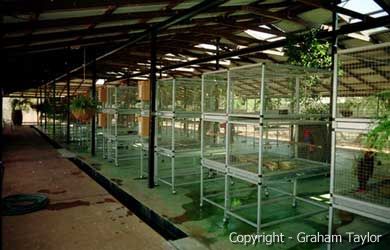 Caption 012: Inside the parrot breeding complex at Pearl Coast Zoo, Western Australia. Graham Taylor. 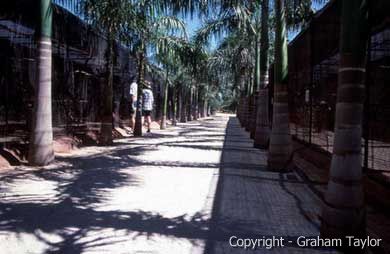 Caption 013: Parrot breeding aviaries at Pearl Coast Zoo, Western Australia. Max Lawrence. 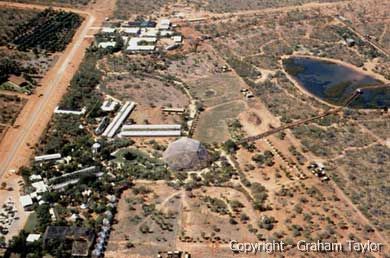 Caption 014: Aerial photo of the aviaries at the Pearl Coast Zoo in Western Australia. Graham Taylor. 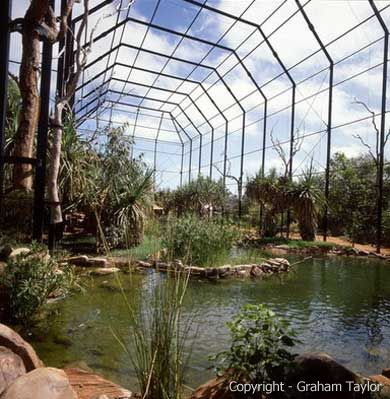 Caption 015: Inside the large Eclectus Parrot aviary at the Pearl Coast Zoo. This aviary housed eight pairs of New Guinea Eclectus Parrots. Max Lawrence. 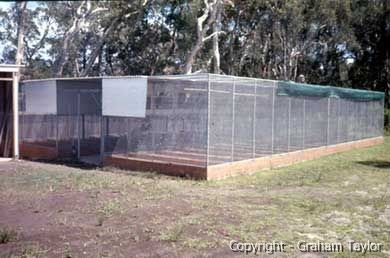 Caption 016: Parrot breeding aviaries once owned by Graham Taylor in the 1980s. |
